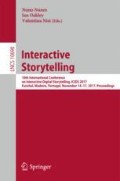Abstract
This paper presents a digitally enhanced model of performer–audience communion in an interactive storytelling setting, based on an intelligent prompt system. The audience response is taken into account through emotion detection; the performer decides about her/his attitude towards the audience. The intelligent prompt advises the performer about how to continue the story. The model, named DoPPioGioco (“DoublePlay”), has been implemented as a prototype system, a virtual environment that realizes a feedback loop between the performer and audience.
Access this chapter
Tax calculation will be finalised at checkout
Purchases are for personal use only
Notes
- 1.
The GEMEP model also encompasses 5 extra emotion types that don’t fit in the categorial classification (Admiration, Tenderness, Disgust, Contempt, Surprise); they have been omitted from the emotion annotation in DoPPioGioco.
- 2.
References
Alrutz, M., Listengarten, J., Wood, M.V.D.: Playing With Theory in Theatre Practice. Palgrave Macmillan, New York (2011)
Aylett, R., Louchart, S.: I contain multitudes: creativity and emergent narrative. In: Proceedings of the 9th ACM Conference on Creativity & Cognition, pp. 337–340. ACM (2013)
Aylett, R.S., Louchart, S., Dias, J., Paiva, A., Vala, M.: FearNot! – an experiment in emergent narrative. In: Panayiotopoulos, T., Gratch, J., Aylett, R., Ballin, D., Olivier, P., Rist, T. (eds.) IVA 2005. LNCS (LNAI), vol. 3661, pp. 305–316. Springer, Heidelberg (2005). https://doi.org/10.1007/11550617_26
Bänziger, T., Scherer, K.R.: Introducing the geneva multimodal emotion portrayal (GEMEP) corpus. Blueprint for affective computing, pp. 271–294 (2010)
Baumer, A., Magerko, B.: Narrative development in improvisational theatre. In: Iurgel, I.A., Zagalo, N., Petta, P. (eds.) ICIDS 2009. LNCS, vol. 5915, pp. 140–151. Springer, Heidelberg (2009). https://doi.org/10.1007/978-3-642-10643-9_19
Brooker, W.: The Audience Studies Reader. Psychology Press, Hove (2003)
Gratch, J., Marsella, S.: Tears and fears: Modeling emotions and emotional behaviors in synthetic agents. In: Proceedings of the Fifth International Conference on Autonomous Agents, pp. 278–285. ACM (2001)
Koenitz, H., Ferri, G., Haahr, M., Sezen, D., Sezen, T.Í. (eds.): Interactive Digital Narrative. History, theory and practice. Routledge, New York (2015)
Lombardo, V., Damiano, R.: Semantic annotation of narrative media objects. Multimed. Tools Appl. 59(2), 407–439 (2012)
Louchart, S., Truesdale, J., Suttie, N., Aylett, R.: Emergent narrative: Past, present and future of an interactive storytelling approach. Interactive Digital Narrative. History, Theory and Practice, pp. 185–199. Routledge, New York (2015)
Mateas, M., Stern, A.: Façade: An experiment in building a fully-realized interactive drama. In: Game Developers Conference, vol. 2 (2003)
Plutchik, R.: Emotion: A psychoevolutionary Synthesis. Harpercollins College Division, New York (1980)
Riedl, M.O., Young, R.M.: Narrative planning: balancing plot and character. J. Artif. Intell. Res. 39(1), 217–268 (2010)
Roberts, D.L., Narayanan, H., Isbell, C.L.: Learning to influence emotional responses for interactive storytelling. In: AAAI Spring Symposium: Intelligent Narrative Technologies, vol. II, pp. 95–102 (2009)
Russell, J.A.: Core affect and the psychological construction of emotion. Psychol. Rev. 110(1), 145 (2003)
Samuel, B., Ryan, J., Summerville, A.J., Mateas, M., Wardrip-Fruin, N.: Bad News: An experiment in computationally assisted performance. In: Nack, F., Gordon, A.S. (eds.) ICIDS 2016. LNCS, vol. 10045, pp. 108–120. Springer, Cham (2016). https://doi.org/10.1007/978-3-319-48279-8_10
Scherer, K.R.: Appraisal theory. In: Dalgleish, T., Power, M. (eds.) Handbook of Cognition and Emotion, pp. 637–663. Wiley, Chichester (1999)
Swartjes, I., Theune, M.: An experiment in improvised interactive drama. In: Nijholt, A., Reidsma, D., Hondorp, H. (eds.) INTETAIN 2009. LNICSSITE, vol. 9, pp. 234–239. Springer, Heidelberg (2009). https://doi.org/10.1007/978-3-642-02315-6_25
Tanenbaum, J.: How i learned to stop worrying and love the gamer: reframing subversive play in story-based games. In: Proceedings of DiGRA (2013)
Weallans, A., Louchart, S., Aylett, R.: Distributed drama management: beyond double appraisal in emergent narrative. In: Oyarzun, D., Peinado, F., Young, R.M., Elizalde, A., Méndez, G. (eds.) ICIDS 2012. LNCS, vol. 7648, pp. 132–143. Springer, Heidelberg (2012). https://doi.org/10.1007/978-3-642-34851-8_13
Zagalo, N., Göbel, S., Torres, A., Malkewitz, R., Branco, V.: INSCAPE: Emotion expression and experience in an authoring environment. In: Göbel, S., Malkewitz, R., Iurgel, I. (eds.) TIDSE 2006. LNCS, vol. 4326, pp. 219–230. Springer, Heidelberg (2006). https://doi.org/10.1007/11944577_23
Acknowledgments
The authors acknowledge James Ryan for having provided the software for the city simulation.
Author information
Authors and Affiliations
Corresponding author
Editor information
Editors and Affiliations
Rights and permissions
Copyright information
© 2017 Springer International Publishing AG
About this paper
Cite this paper
Damiano, R., Lombardo, V., Pizzo, A. (2017). Thinning the Fourth Wall with Intelligent Prompt. In: Nunes, N., Oakley, I., Nisi, V. (eds) Interactive Storytelling. ICIDS 2017. Lecture Notes in Computer Science(), vol 10690. Springer, Cham. https://doi.org/10.1007/978-3-319-71027-3_17
Download citation
DOI: https://doi.org/10.1007/978-3-319-71027-3_17
Published:
Publisher Name: Springer, Cham
Print ISBN: 978-3-319-71026-6
Online ISBN: 978-3-319-71027-3
eBook Packages: Computer ScienceComputer Science (R0)

